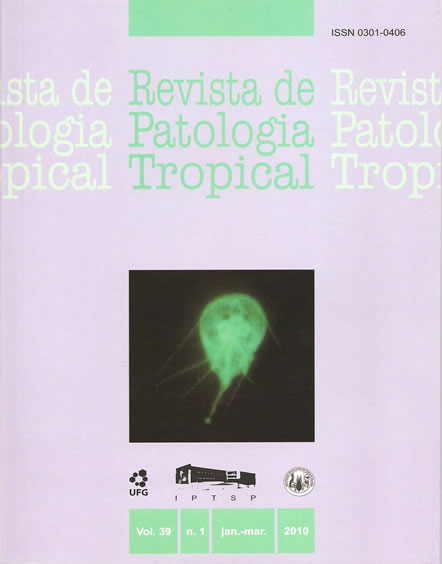Blastocystis hominis and Entamoeba histolytica/Entamoeba dispar infection in patients attended in a Hospital in Niterói, Rio de Janeiro, Brazil
DOI:
https://doi.org/10.5216/rpt.v39i1.9499Keywords:
Blastocystosis, Amebiasis, Infection, Enteroparasitosis.Abstract
Blastocystosis and amebiasis are intestinal parasitoses caused by the protozoanB. hominis and E. histolytica/E. dispar. While E. histolytica is the only species
considered invasive, E. dispar is morphologically identical although genetically
distinct, and it is considered incapable of invading the intestinal mucosa. One of
the most important aspects in the virulence of the ameba might be their interaction
with the macrobiota that lives in the host’s intestine. B. hominis is found with high
frequency in feces, and in association with E. histolytica/E. dispar, suggesting
possible reciprocal interference of pathogenicity. The aim of this paper is to show
the frequency of E. histolytica/E. dispar, B. hominis and their association on feces
samples of patients seen at Hospital Universitário Antônio Pedro (HUAP) in
2008 through a survey of the register of test results for feces samples. The overall
frequency of intestinal parasites was 14.1%. B. hominis was the most frequent
(6.7%), followed by E. coli (3.4%), G. lamblia (2.9%) and E. histolytica/E. dispar
(2.0%). Association with B. hominis was found in 20 (58.8%) of 34 positive
E. histolytica/E. dispar cases. The presence of multiple parasites in the studied
population suggests a difficult access to adequate sanitation. The high number of
cases with E. histolytica/E. dispar and B. hominis association shows the need to
develop experimental models for the study of this association in vivo.
Downloads
Downloads
Published
How to Cite
Issue
Section
License
The manuscript submission must be accompanied by a letter signed by all authors stating the full name and email address, confirming that the material has not been published or is under consideration for publication elsewhere, and agreeing to transfer copyright in all media and formats for Journal of Tropical Pathology. The authors will not be paid for published articles. They are solely responsible for the content of those articles, even if the Editor holds the right to adjust them to the norms of the journal.
The reviewers will not be paid for the peer review process.

